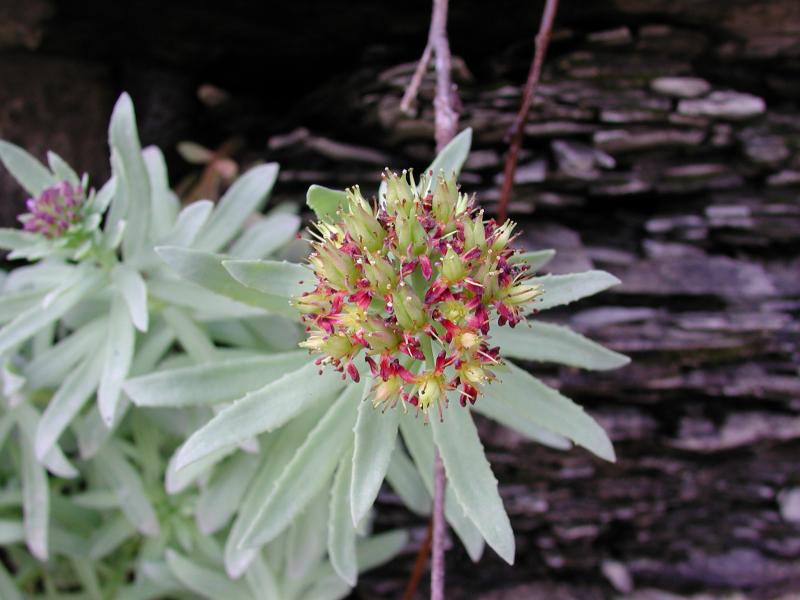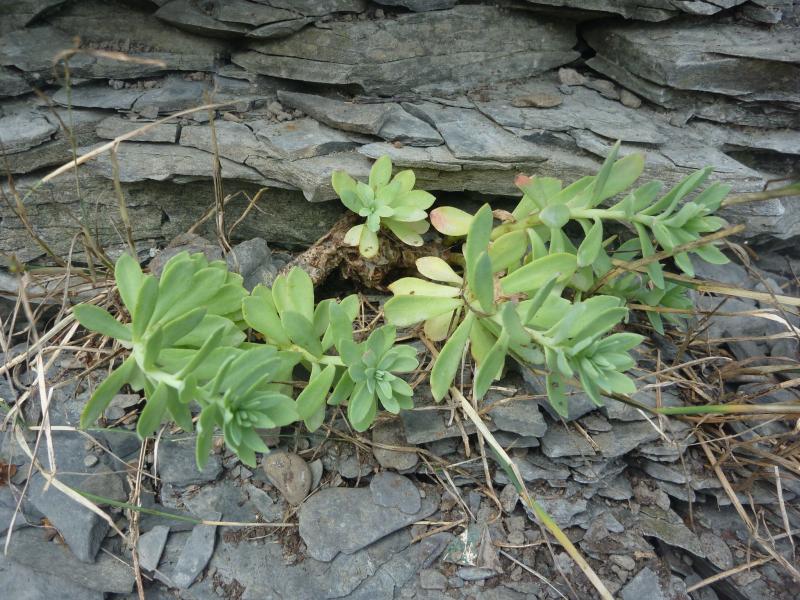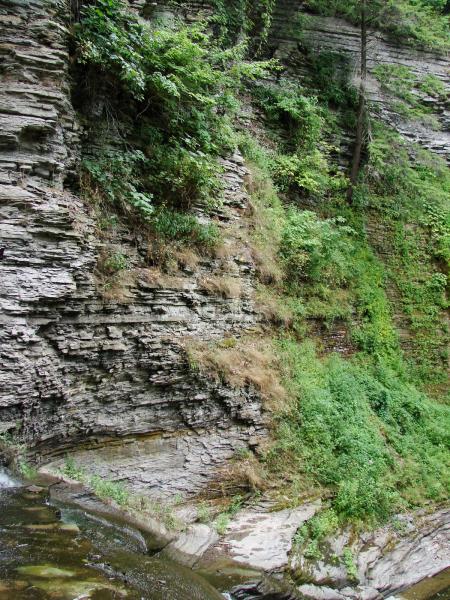Leedy's Roseroot
Rhodiola integrifolia ssp. leedyi (Rosendahl & Moore) Kartesz
- Class
- Dicotyledoneae (Dicots)
- Family
- Crassulaceae (Stonecrop Family)
- State Protection
- Endangered
Listed as Endangered by New York State: in imminent danger of extirpation in New York. For animals, taking, importation, transportation, or possession is prohibited, except under license or permit. For plants, removal or damage without the consent of the landowner is prohibited.
- Federal Protection
- Threatened
Listed as Threatened under the Federal Endangered Species Act
- State Conservation Status Rank
- S1
Critically Imperiled in New York - Especially vulnerable to disappearing from New York due to extreme rarity or other factors; typically 5 or fewer populations or locations in New York, very few individuals, very restricted range, very few remaining acres (or miles of stream), and/or very steep declines.
- Global Conservation Status Rank
- G5T1T2
Summary
Did you know?
Leedy's roseroot was first collected at Watkins Glen collected in 1918 by L. F. Randolph, a botanist from Cornell University. He didn't say how many plants he saw there but he described its location as the same place where only one plant was rediscovered in 1991. That population was destroyed by trail construction in 2017. There may be potential for reintroduction of this species in appropriate habitat at Watkins Glen or nearby.
State Ranking Justification
There are now two existing populations, of which is very large, and one extirpated site. There are no other known historical populations.
Short-term Trends
The two known extant populations appear to be fairly stable with no large fluctuations in numbers.
Long-term Trends
Two of the three populations have been known since the early 1800s and early 1900s. A third population was discovered in 1994, and one was extirpated in 2017.
Conservation and Management
Threats
One small population is threatened by the encroachment of woody vegetation. The large population is threatened by a growing swallowwort population and a large infestation of Japanese knotweed.
Conservation Strategies and Management Practices
Remove swallow-wort from areas near the populations and study the effect of knotweed on its growth and reproduction. Prevent new construction of docks and stairways that would cover existing plants.
Research Needs
Research is being performed on the effect of Japanese knotweed on the population at Seneca Lake. More research is needed on the spread of swallowwort into the population.
Habitat
Habitat
In New York Leedy's Roseroot is known only from mesic or seepy sandstone, siltstone and shale cliffs of circumenutral pH (New York Natural Heritage Program 2013). Cool seeps in rocks (FNA 2010). Calcareous cliffs (Fernald 1970).
Associated Ecological Communities
- Cliff community
(guide)
A community that occurs on vertical exposures of resistant, non-calcareous bedrock (such as quartzite, sandstone, or schist) or consolidated material; these cliffs often include ledges and small areas of talus.
- Shale cliff and talus community
(guide)
A community that occurs on nearly vertical exposures of shale bedrock and includes ledges and small areas of talus. Talus areas are composed of small fragments that are unstable and steeply sloping; the unstable nature of the shale results in uneven slopes and many rock crevices.
Associated Species
- Acer saccharum (sugar maple)
- Amelanchier arborea (downy shadbush)
- Aquilegia canadensis (wild columbine, red columbine)
- Asplenium platyneuron (ebony spleenwort)
- Cryptogramma stelleri (slender cliff-brake, Steller's cliff-brake)
- Cystopteris bulbifera (bulblet fern)
- Draba arabisans (rock whitlow-grass)
- Geranium robertianum (herb-Robert)
- Parietaria pensylvanica (Pennsylvania pellitory)
- Parthenocissus vitacea
- Penstemon hirsutus (hairy beard-tongue)
- Poa compressa (flat-stemmed blue grass, Canada blue grass)
- Rubus odoratus (purple-flowering raspberry)
- Tussilago farfara (colts-foot)
Range
New York State Distribution
In New York Leedy's Roseroot is limited to cliff faces near the southern portion of Seneca Lake and the immediate vicinity.
Global Distribution
This subspecies is known only from two counties each in southeastern Minnesota and central New York.
Identification Comments
General Description
Rhodiola integrifolia ssp. leedyi is a distinctive-looking, moderately-sized, succulent, native perennial plant that reaches up to 45 cm tall. Its leaves are blue-green and narrowly lanceolate with their tapered end at the base (oblanceolate), and 3 to 5.5 cm long by 0.5 to 1.5 cm wide. The flowering stems appear annually with male and female flowers on separate plants (dioecious). The inflorescences are dense, flat-topped clusters up to 8 cm across, with up to 250 flowers, with those borne on the main axis and branch ends opening first. The petals are elliptic-oblong, dark red throughout or usually greenish yellow at their base, and 1.5 to 5mm long. They are erect in pistillate flowers, and spreading and hooded in staminate flowers. The seeds are winged, pear-shaped or lanceolate, have spreading beaks, and are borne in 4 to 9 mm dry pods (FNA 2010).
Identifying Characteristics
Rhodiola integrifolia ssp. leedyi is a distinctive looking, moderately sized, succulent, native perennial plant that reaches up to 45 cm tall. Its leaves are blue-green and narrowly lanceolate with their tapered end at the base (oblanceolate), and 3 to 5.5 cm long by 0.5 to 1.5 cm wide. The flowering stems appear annually with male and female flowers on separate plants (dioecious). The inflorescences are dense, flat-topped clusters up to 8 cm across, with up to 250 flowers, with those borne on the main axis and branch ends opening first (corymbose cyme). The petals are elliptic-oblong, dark red throughout or usually greenish yellow at their base and 1.5 to 5mm long. They are erect in pistillate flowers, and spreading and hooded in staminate flowers. The seeds are winged, pear-shaped or lanceolate with the tapered end at the base and spreading beaks, and are borne in 4 to 9 mm dry pods (FNA 2010).
Best Life Stage for Proper Identification
Do not collect this species for identification puposes. For positive identification the whole Plants with leaves, flowering stem and intact mature flowers should be observed. In addition, a description of the habitat and location should be made, and a picture of the plant should be taken.
Similar Species
Rhodiola rosea (sensu stricto) has narrow petals (about 1 mm or less) that are usually yellow or yellowish, but are sometimes red towards the tip, and pale green, usually glacuous leaf baldes. In contrast Rhodiola integrifolia ssp. leedyi's petals are 1 to 1.8 mm wide, dark red throughout or greenish yellow at their bases. Rhodiola rosea is also restricted to the Catskills, Hudson Valley, and Adirondacks, while R intergrifolia ssp. leedyi occurs only in central New York. There are also escaped cultivars of Rhodiola and Sedum which may invade rocky habitats near settlement. The common escaped Sedum species can be distinguished by their yellow to golden yellow flowers and bright green leaves.
Best Time to See
Flowers mid-May through August, fruits may persist through the summer into frost.
- Vegetative
- Flowering
- Fruiting
The time of year you would expect to find Leedy's Roseroot vegetative, flowering, and fruiting in New York.
Leedy's Roseroot Images
Taxonomy
Leedy's Roseroot
Rhodiola integrifolia ssp. leedyi (Rosendahl & Moore) Kartesz
- Kingdom Plantae
- Phylum Anthophyta
- Class Dicotyledoneae
(Dicots)
- Order Rosales
- Family Crassulaceae (Stonecrop Family)
- Order Rosales
- Class Dicotyledoneae
(Dicots)
- Phylum Anthophyta
Additional Common Names
- Rose Sedum
Synonyms
- Rhodiola integrifolia Raf. [in part.]
- Sedum integrifolium ssp. leedyi (Rosendahl & Moore) Clausen
- Sedum rosea ssp. integrifolium (Raf.) Berger [in part.]
- Sedum rosea var. leedyi Rosendahl & Moore
Comments on the Classification
The taxonomy of this plant may be questioned. It is currently aligned with Rhodiola integrifolia ssp. leedyi, a very rare and local plant known from southeastern Minnesota. There is a strong possibility that our plants are something different, but undescribed. Many authors have lumped this under Rhodiola rosea or placed it as a variety of Rhodiola rosea.
Additional Resources
Best Identification Reference
Flora of North America Editorial Committee. 2010. Flora of North America North of Mexico. Vol. 08. Magnoliophyta: Paeoniaceae to Ericaceae. Oxford Univ. Press, New York. xxiv + 585 pp.
Other References
Gleason, Henry A. and A. Cronquist. 1991. Manual of Vascular Plants of Northeastern United States and Adjacent Canada. The New York Botanical Garden, Bronx, New York. 910 pp.
Holmgren, Noel. 1998. The Illustrated Companion to Gleason and Cronquist's Manual. Illustrations of the Vascular Plants of Northeastern United States and Adjacent Canada. The New York Botanical Garden, Bronx, New York.
Mitchell, Richard S. and Gordon C. Tucker. 1997. Revised Checklist of New York State Plants. Contributions to a Flora of New York State. Checklist IV. Bulletin No. 490. New York State Museum. Albany, NY. 400 pp.
New York Natural Heritage Program. 2024. New York Natural Heritage Program Databases. Albany, NY.
Weldy, T. and D. Werier. 2010. New York flora atlas. [S.M. Landry, K.N. Campbell, and L.D. Mabe (original application development), Florida Center for Community Design and Research http://www.fccdr.usf.edu/. University of South Florida http://www.usf.edu/]. New York Flora Association http://newyork.plantatlas.usf.edu/, Albany, New York
Zaremba, Robert E. 1991. Corrections to phenology list of April 9, 1991.
Links
About This Guide
This guide was authored by: Stephen M. Young, Elizabeth Spencer, Richard M. Ring.
Information for this guide was last updated on: August 6, 2020
Please cite this page as:
New York Natural Heritage Program. 2024.
Online Conservation Guide for
Rhodiola integrifolia ssp. leedyi.
Available from: https://guides.nynhp.org/leedys-roseroot/.
Accessed April 26, 2024.




